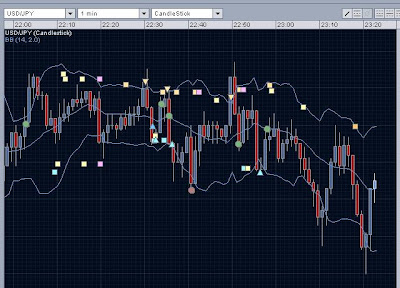One-PIP Range Trading Strategy:
1. Look for a Ranging Pair for 1 min Chart
2. Limit Buy or Limit Sell at the inner edge of Bollinger bands.
3. Where possible enter position in direction of Long Term trend, eg short at upper Bollinger band where Long Term is bearish, and long at lower Bollinger band where Long Term is bullish. Long Term could be 1 hour or 1 day chart.
4. Alternatively, if Long Term is also Ranging, eg, if the hourly chart is ranging, then enter position in the direction of the expected price swing. But if it conflicts with the daily chart, give preference to the daily chart. (For this discussion, we assume the daily chart and the hourly chart are in agreement. ) In the hourly chart the price is at upper edge of Bollinger band, then in the 1 min chart, enter a short at the upper Bollinger band as well.
5. Set TP as close as possible to opening price, eg, 1 pip
6. Let SL be Oanda's default which is usually around 10-20 pips
7. Enter 1000 units (instead of the usual 200 or 500) to make the 1 pip give better yield.
8. Ensure that the currency pair is highly volatile and liquid
I shall now illustrate item number 4 above (highlighted in red) with CHF-JPY.
We first look at the daily chart:

The daily chart above shows that the price is at the upper end of the Bollinger band. This means that it should reverse soon and start going down. Therefore, we should not open a long position. Instead any position we open should be a short position.
Next, we look at the hourly chart:

The hourly chart above shows that the price is on the way down. This indicates that the price is still in the upper band of the Bollinger band. As such there is still some posibility that the price will still go down - in order to reach the lower edge of the Bollinger band. This means that we should not open any long positions. Any positions we open should be a short position. Howerver, do note that if there is a conflict between the Daily Chart and the Hourly Chart, you should follow the Daily Chart. Eg, if the daily chart indicates that the price is at upper edge of Bollinger band and is about to swing down, do open a short position. If the Hourly chart shows the price is at bottom of Bollinger band, the Daily chart should be given preference, because it indicates price behaviour in the Long Term.
And finally we come to the 1-minute chart:

You will note that I have inserted a Limit Sell (short position) on the upper edge of the Bollinger Band. I should never put a Limit Buy (long position) because, we have seen that the daily chart as well as the hourly chart indicates the price is going down.



























